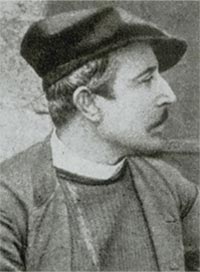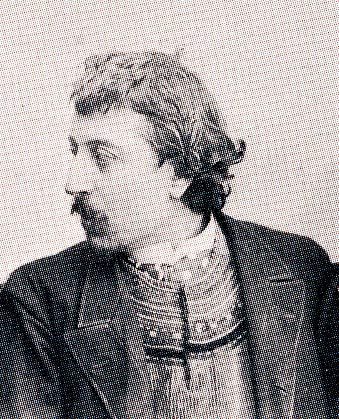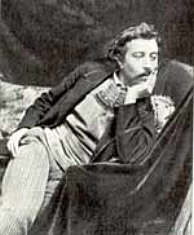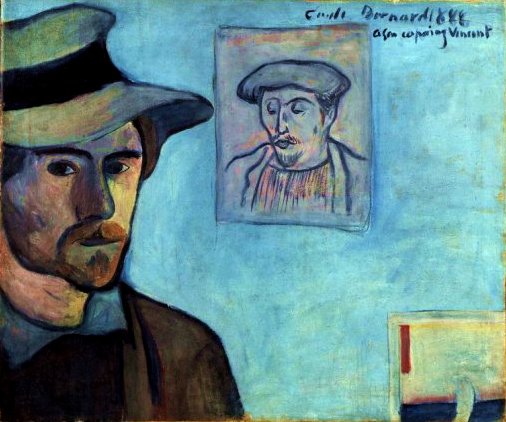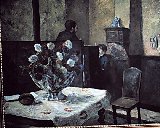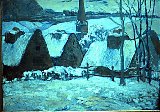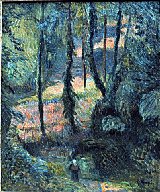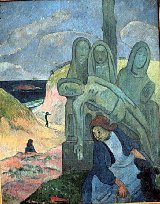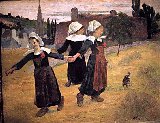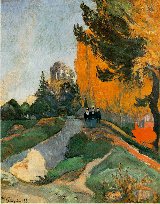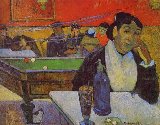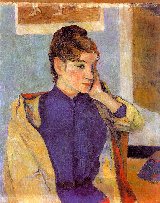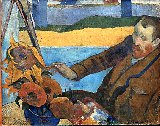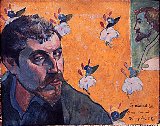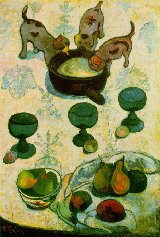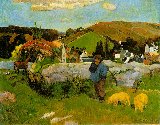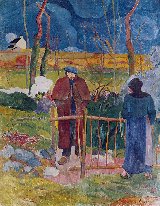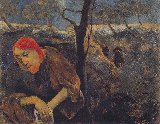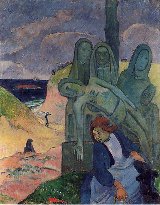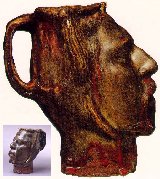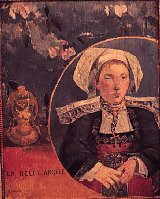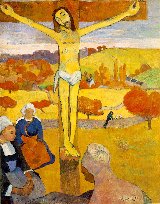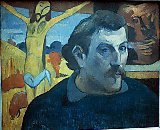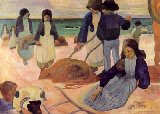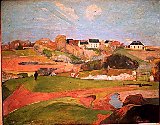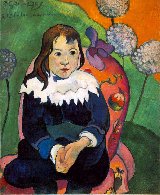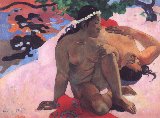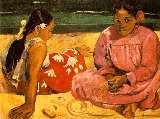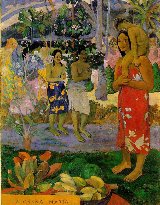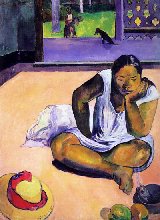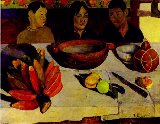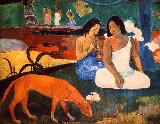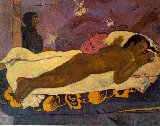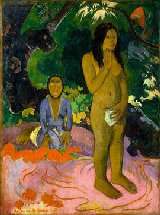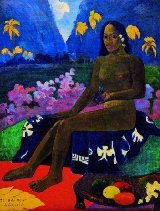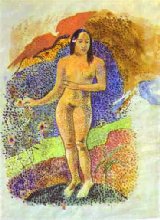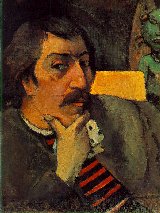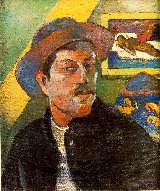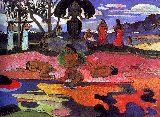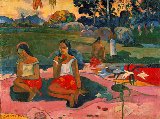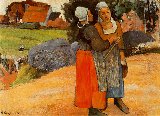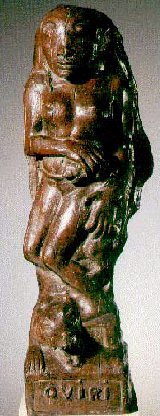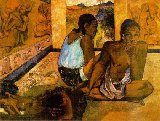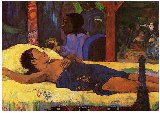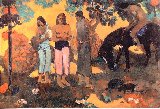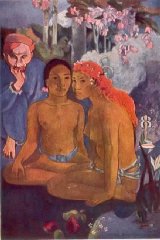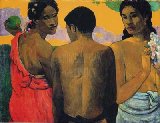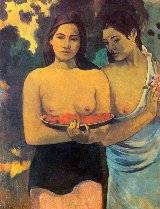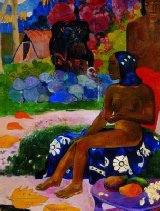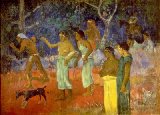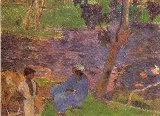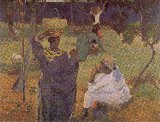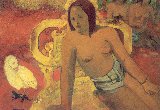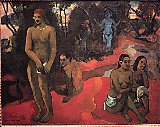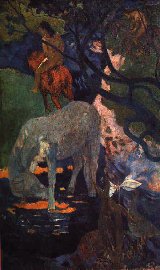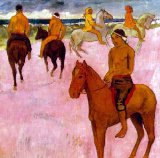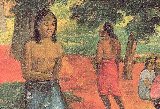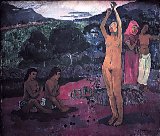 |
||||
|
Paul Gauguin
The Life, Paintings & Sculptures of Paul Gauguin
Eugène-Henri-Paul Gauguin (Paris June 7, 1848 - May 9, 1903, Atuona, Hiva Oa, Marquesas Islands) was a Symbolist/Post-Impressionist) painter/sculptor. He was born in France and died in French Polynesia. one of the leading French painters of the Postimpressionist period, whose development of a conceptual method of representation was a decisive step for 20th-century art. After spending a short period with Vincent van Gogh in Arles (1888), Gauguin increasingly abandoned imitative art for expressiveness through colour. From 1891 he lived and worked in Tahiti and elsewhere in the South Pacific. His masterpieces include the early "Vision After the Sermon" (1888) and "Where Do We Come From? What Are We? Where Are We Going?" (1897-98). Gauguin’s artistic development of a conceptual method of representation was important for the history of art as it moved into the twentieth century. The name for the movement was called by Jean Moreas Symbolism, “ as the only name capable of giving a reasonable definition of the present trend of the creative in spirit in art.” Its essential character was, “to clothe an idea in a visible form.” Although his main achievements were to lie elsewhere, Gauguin was, to use a fanciful metaphor, nursed in the bosom of Impressionism. His attitudes to art were deeply influenced by his experience of its first exhibition, and he himself participated in those of 1880, 1881 and 1882. The son of a French journalist and a Peruvian Creole, whose mother had been a writer and a follower of Saint-Simon, he was brought up in Lima, joined the merchant navy in 1865, and in 1872 began a successful career as a stockbroker in Paris. Painters no longer aimed at depicting the outer world but at rendering their inner dreams by symbolic allusion and decorative form. Line and color developed their powers of expression, taking inspiration in global art from Japanese art prints to primitive African art.
In 1874 he saw the first Impressionist exhibition, which completely entranced him and confirmed his desire to become a painter. He spent some 17,000 francs on works by Manet, Monet, Sisley, Pissarro, Renoir and Guillaumin. Pissarro took a special interest in his attempts at painting, emphasizing that he should `look for the nature that suits your temperament', and in 1876 Gauguin had a landscape in the style of Pissarro accepted at the Salon. In the meantime Pissarro had introduced him to Cézanne, for whose works he conceived a great respect---so much so that the older man began to fear that he would steal his `sensations'. All three worked together for some time at Pontoise, where Pissarro and Gauguin drew pencil sketches of each other (Cabinet des Dessins, Louvre). On the subject of line and drawing, Gauguin said in 1879, “One must draw and draw again…It is only by drawing often, drawing everything, drawing incessantly, that one day you are amazed to discover that you have found the way to render a thing with its own character…don’t make pretty, clever little lines, but be simple and insist on the major lines that count…” In 1883-84 the bank that employed him got into difficulties and Gauguin was able to paint every day. He settled for a while in Rouen, partly because Paris was too expensive for a man with five children, partly because he thought it would be full of wealthy patrons who might buy his works. Rouen proved a disappointment, and he joined his wife Mette and children, who had gone back to Denmark, where she had been born. His experience of Denmark was not a happy one and, having returned to Paris, he went to paint in Pont-Aven, a well-known resort for artists. Gauguin said himself about his drawings that “It always seems to me that something is missing: the color.” Though based, to use Gauguin’s words, on “sharpness of outline,” it is their color that brings Gauguin’s best drawings and paintings to life. It is the novel color harmonies, inspired and heightened by his travels to the tropics that give his work a hallucinatory richness that has never been matched. His legacy of expressionistic color and composition inspired the twentieth century and continues to excite contemporary artists of the twenty first. 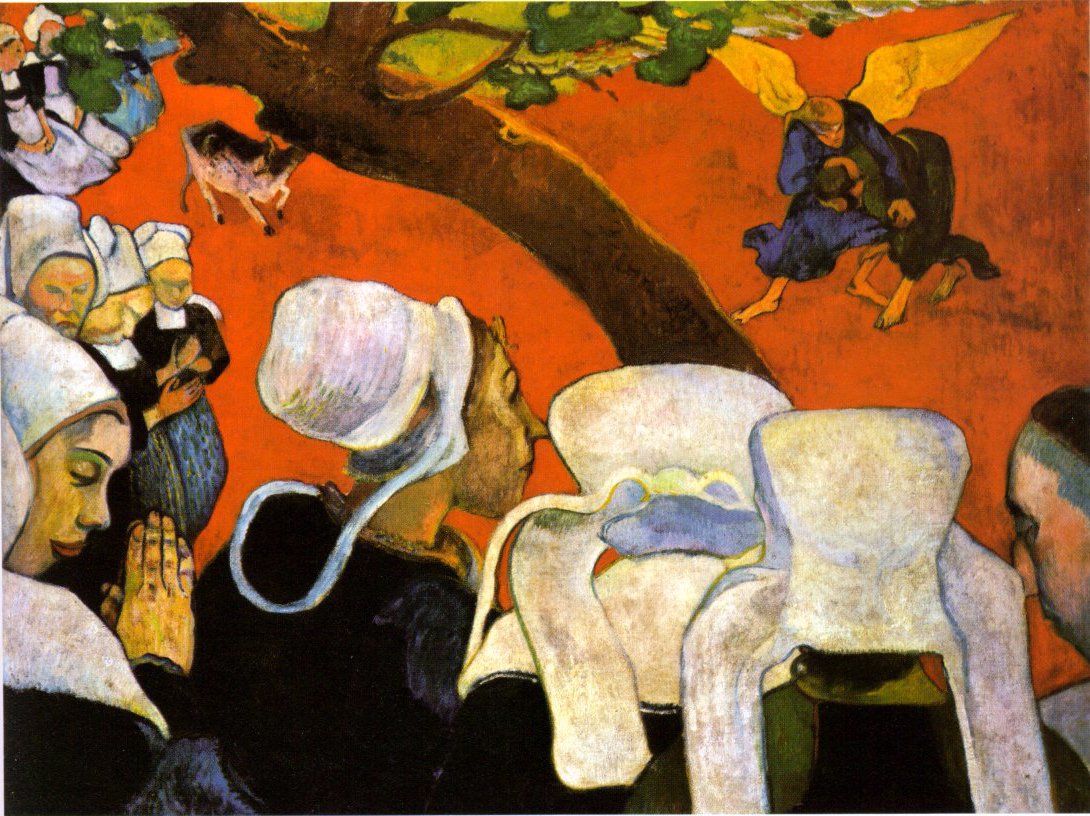
Paul Gauguin - Vision after the Sermon: Jacob's Struggle with the Angel, 1888. Gauguin’s father died the year after Gauguin was born and he was raised by his mother in Peru, “that wonderful land where it never rains,” Gauguin was destined to travel throughout his lifetime and find inspiration in exotic lands. Gauguin joined the merchant navy in 1865, and in 1872 began a successful career as a stockbroker in Paris. In 1973 he married Mette Gad, a pretty Danish society girl and had five children within ten years. Gauguin collected oriental carpets, pottery, Japanese prints, and art by Pissarro, Manet, Sisley, Renoir, Monet, Guillaumin, Daumier and Degas. Pissarro became a friend and painting teacher as Gauguin began to paint himself. He worked with Van Gogh and Degas who bought several of Gauguin’s paintings. If his career started late and developed slowly, he had the advantage of entering into immediate contact with the living art of his day. In 1883-84 the bank that employed Gauguin got into financial difficulties and Gauguin began to paint every day. His wife and children moved to Denmark and so began his tumultuous years as an artist. He traveled to Denmark, then lived in Rouen, both times attempting to make a viable life with his family and painting. His mind was obsessed with theoretical foundations of his art and painting that proclaimed his personal vision. “The further I go, the more I feel sure that thoughts can be expressed by something quite different from literature,” he wrote.
In 1887 Gauguin leaves for Panama and Martinique, where he paints several landscapes prefiguring his Tahitian pictures. He returns to Paris and Theo Van Gogh organizes Gauguin’s first one-man show in Paris. In 1889 he stopped working exclusively out-of-doors, as Pissarro had taught him, and generally began to adopt a more independent line. His meeting with van Gogh, the influence of Seurat, the doctrines of Signac, and a rediscovery of the merits of Degas--especially in his pastels--all combined with his own streak of megalomania to produce a style that had little in common with the thoughtful lyricism of the work of his erstwhile mentor Pissarro. Monet confessed to a liking of his Jacob Wrestling with the Angel (1888; National Gallery of Scotland), which he saw at the exhibition Gauguin organized in 1891 to finance his projected excursion to places where he could live on `ecstasy, calmness and art'; the proceeds amounted to 10,0000 francs, some of it coming from Degas, who bought several paintings. There were still evident in these new works traces of pure Impressionism, and of the very clear influence of Cézanne (as in the Portrait of Marie Lagadu, 1890; Art Institute of Chicago)--a fact pointed up by a Cézanne still life owned by Gauguin which is shown behind her--but basically this period marked the parting of the ways between Gauguin and Impressionism. 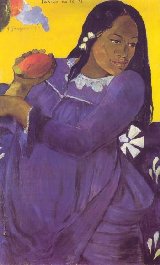
Paul Gauguin - Vahine no te vi/Woman of the Mango, 1892. In 1891 he sails for Tahiti and acquires a native hut in the Mataiea district. He has two fruitful years before returning to Europe with ill health. He returns to Tahiti in 1895 and has more fruitful years despite illness and trouble with local authorities. 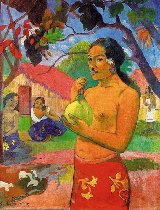
Paul Gauguin - Woman Holding a Fruit, 1893. During 1897 - 1898 he made many variations of the same painting: "D'ou venons nous? Que sommes nous? D'ou allons nous? (where do we come from? What are we? Where are we going?)". Although Gauguin was settled in Tahiti in 1898 when he painted The White Horse, it does not primarily suggest a local connection but rather a final outcome of the sense of newly tapped powers in color and new sensations to be derived from it that had been the preoccupation of a whole half-century. The seed of Impressionism, it might be said, expanded here into a marvellous exotic bloom. The color, however, is no longer descriptive or atmospheric but makes an impact on the senses akin to that of music. The white horse itself suggests some creature of heroic fable, yet while it shares this appearance of belonging to an imaginary world with the riders in the background, the picture had its basis in Polynesian reality. The inhabitants used horses as a means of transport in the absence of roads and bridges. Bengt Danielsson, the anthropologist and historian, in his book Gauguin in the South Seas, makes this remark with special reference to the Marquesas where `everyone still rides a horse from the bishop down to the smallest native boy'. Gauguin did not move to the Marquesas until 1901 but as this picture shows the native horsemanship had already caught his attention. In 1901 Gauguin sought still more distant and freer lands, the Marquesas Islands, where he built a cabin he called the House of Joy on the beautiful island of Dominique. Gauguin died there in 1903.
Chronological List of Works: 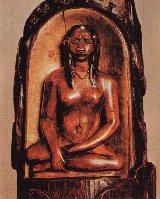
Paul Gauguin - Maurka, c1895.
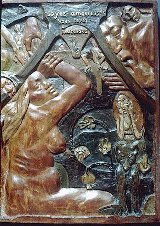
Paul Gauguin - Be in Love and You Will Be Happy, 1899.
|
|
|||
|
|
||||
|
|
||||
